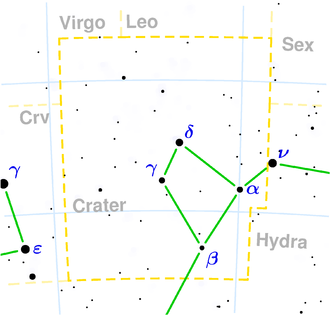NGC 3505
| Galaxy NGC 3505 / NGC 3508 / IC 2622 |
|
|---|---|

|
|
| SDSS recording | |
| AladinLite | |
| Constellation | cups |
|
Position equinox : J2000.0 , epoch : J2000.0 |
|
| Right ascension | 11 h 02 m 59.7 s |
| declination | -16 ° 17 ′ 22 ″ |
| Appearance | |
| Morphological type | SA (r) b / pec? / HII |
| Brightness (visual) | 13.2 mag |
| Brightness (B-band) | 14.0 mag |
| Angular expansion | 1.1 ′ × 0.9 ′ |
| Position angle | 15 ° |
| Surface brightness | 13.0 mag / arcmin² |
| Physical data | |
| Redshift | 0.013006 ± 0.000030 |
| Radial velocity | 3899 ± 9 km / s |
|
Stroke distance v rad / H 0 |
(166 ± 12) · 10 6 ly (51 ± 3.6) Mpc |
| history | |
| discovery | William Herschel (NGC 3508) John Herschel (NGC 3505) Lewis Swift (IC 2622) |
| Discovery date | December 31, 1785 May 7, 1836 January 14, 1898 |
| Catalog names | |
| NGC 3505/3508 • IC 2622 • PGC 33362 • MCG -03-28-031 • IRAS 11005-1601 • 2MASX J11025967-1617220 • GC 2288, 2291 • H II 507 • h 3312, 814 • | |
NGC 3505 = NGC 3508 = IC 2622 is a spiral galaxy with extensive star formation regions of the Hubble type Sb in the constellation Becher in the southern sky . It is estimated to be 193 million light years from the Milky Way and about 60,000 light years across .
The object was discovered on December 31, 1785 by Wilhelm Herschel with a 48 cm telescope.
